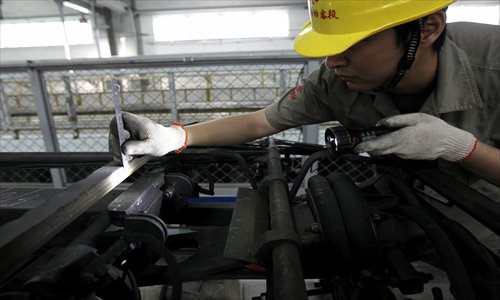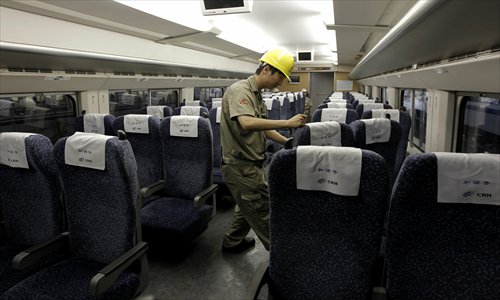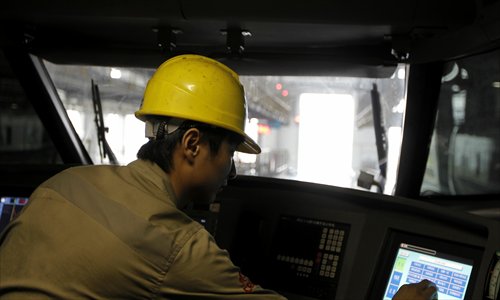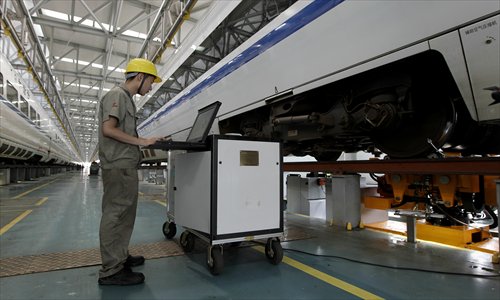The end of the line

Under the night sky, workers carry out their final checks on a bullet train that has been cleaned and serviced. Photo: Yang Hui/GT

Workers clean the aerodynamically-designed windscreen on a bullet train. Photo: Yang Hui/GT

A technician measures the width of one of the sliding carbon strips on the top of a train. Photo: Yang Hui/GT

A worker checks the seats inside a bullet train. Photo: Yang Hui/GT

Technician Huang Junhao checks a train driver's cabin. Photo: Yang Hui/GT

A worker checks a bullet train's wheel alignments with a computer. Photo: Yang Hui/GT
With the new Nanjing-Hangzhou High-Speed railway route beginning on Monday, Shanghai's railway stations will be seeing more bullet trains every day. But the city's busy railway stations are only temporary stopovers for these trains. Where do they go at the end of the day after running thousands of kilometers? Where do they go to be cleaned and checked, oiled, greased and maintained?
The Global Times discovered one of the three Shanghai homes and repair centers for these sleek futuristic trains. When the trains complete their work for the day, some of them head to this huge workshop in Jiangqiao town, Jiading district. The workshop opened in June 2009 and is one of six workshops belonging to the Shanghai Electric Multiple Units (EMU) and Coach Train Section.
It is to this workshop that the bullet trains running between Shanghai and Nanjing, Shanghai and Wenzhou, Shanghai and Xiamen, Shanghai and Fuzhou and on other routes come for their regular maintenance checks and cleaning. More than 340 people work here in Jiading. During the day they check, repair and maintain eight trains at a time and at night they work on up to 20 trains at a time.
According to Miao Lipei, the assistant officer with the Party Committee of the Shanghai EMU and Coach Train Section, the busiest period for workers and engineers happens between 1 am and 2 am every day. "About 30 staff work on each night shift. It usually takes them around two hours to check and repair each train," he told the Global Times.
All the technical staff here are highly qualified but before they enter the workshop every shift, they don insulated footwear, protective helmets and leave their mobile phones in their lockers - a precaution against electronic interference with the equipment, Miao said.
Their major tasks involve checking the high-voltage equipment and measuring the width of the sliding carbon strips on the tops of the trains, checking the seats and water supply systems inside the cabins and examining the undercarriage. "Every part of the maintenance work is vital. When we measure the width of the sliding carbon strips, we help eliminate the possibility of the power being lost on a journey due to poor contact," Miao said.
The technicians carry torches when they do their work - but these are not ordinary torches. They not only provide light but record images and voices as the maintenance work proceeds. "Other technicians examine the videos to further ensure that everything is working properly."
Miao said most of the technicians in the workshop were aged around 35. "We don't employ people over 45 because the job is physically demanding. And given that the job needs people who can learn and adapt to new technologies quickly, we believe younger people are better at this."
The Shanghai EMU and Coach Train Section runs other workshops in Hangzhou and in Nanjing, and altogether more than 2,000 staff work in the six workshops to ensure the safety and cleanliness of 300 bullet trains.
While the technicians work to ensure the continuing efficiency of the high-speed bullet trains, other staff are busy keeping the insides and outsides gleaming. Cleaners inside pick up any rubbish left by travelers, mop the floors and wipe the surfaces.
Outside machines clean much of the trains' exteriors although the aerodynamically-designed front and back windscreens are cleaned manually.